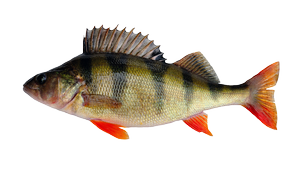
PERCH
Found in lakes, streams and rivers, perch is easy to recognize by its yellow-white belly, dark stripes on the sides and red fins. The depth of the color varies depending on the water, the bottom and the diet. Perch can grow to one and a half meters long and weigh more than 4 kg, but the perch sold by your fishmonger normally weigh less than a kilo.
Fish facts
The fins are sharp and it’s easy to get stabbed by them. The scales can be hard to remove. Perch flesh is lean and fish weighing less than a kilo have the best flavor. They’re said to taste best in spring.
How to cook perch
Perch is a delicacy that can be used as a substitute for sole and other tasty flatfish. A common piece of advice from practiced fish chefs when it comes to perch is (you've heard it before) not to over-complicate things.
Fry perch in a pan, coated or uncoated. It’s best to scale it so that your diners can enjoy the taste of the skin, fried salty and crisp. Scale the fish before gutting it, hold it by the tail and scrape towards the head. Use a scaler or a blunt knife.
There are ways of filleting perch so that it’s completely free of bones. Ask your fishmonger to do it for you if you find it tricky.
Avoid grilling perch whole because it can be a dry and bony experience for your guests.
Perch goes exceptionally well with parsley. Perch stuffed with parsley is a classic. Chanterelles fried in butter are good with it too.
Deep fried perch with French fries is a more luxurious, daintier variation on fish & chips. Partner the lean, great-tasting flesh with a sharp, rich sauce, such as tartar sauce.
The classic
No frills: Stuffed perch fillet with butter, finely chopped leek, dill, parsley and cream.
Conservation status:
Green. Yellow in the Baltic Sea.
World Wide Fund for Nature
Marine Stewardship Council
Aquaculture Stewardship Council
Organic








